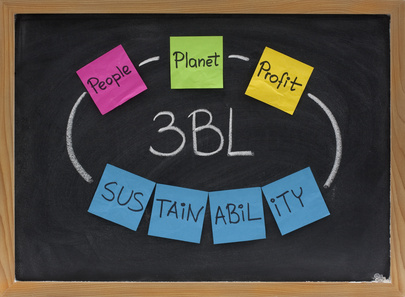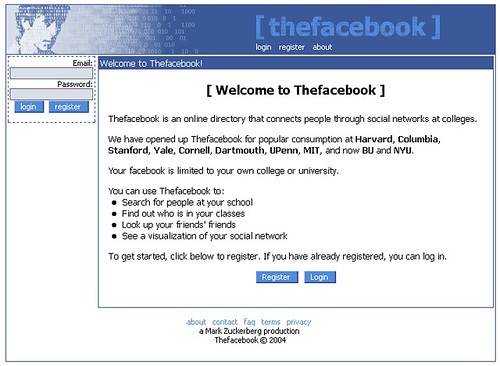This is a guest post by Adam Leiter.
We all know that social media is about more than just putting out messages and shouting with a bullhorn. While the copyright may still legally belong to the business, today it’s the audience that truly owns the brand. Social media gives them the power to take content in new directions, thus causing us to react and respond accordingly. The good news is that, as practitioners, we can guide our clients towards positive experiences by embracing a triple bottom line mentality. This practice allows us to avert the shouting match and instead ensure a true dialogue by starting conversations around our clients, engaging with the right audiences, and enhancing what is being discussed.

Although some communications professionals may think that triple bottom line social means using Facebook, Twitter, AND LinkedIn, we’re going to take a little bit more of a philosophical approach than that. The term triple bottom line (TBL), also known as people, planet, profit, comes from the world of sustainability-focused business. It captures an expanded spectrum of values and criteria for measuring organizational (and societal) success: economic, ecological, and social, and makes a case for companies to account for the full cost and impact of doing business.
People – This refers to the fair and beneficial treatment of employees, as well as the social community in which a corporation conducts business. A TBL company seeks to benefit many constituencies because of interdependency, not exploit them. Fair labor practices, safe work environments, and involvement with community healthcare and education are some examples of this leg of the stool.
Planet – Revolving around sustainable environmental practices, a TBL company works to benefit the environment as much as possible or at the least cause minimal impact. A few basic ways that businesses measure this area are management of energy consumption, waste reduction and sustainability reporting.
Profit – Although this is tied to the internal profit made by a company, in TBL terms, true profit is the economic value created by the organization after deducting the cost of all inputs, including the cost of the capital tied up. It is the real economic impact the organization has on its economic environment.
In the end, by focusing on more than just a single bottom line of revenue, businesses adhering to a TBL model see a return in brand loyalty, employee productivity, energy expenses and hiring attrition expenses.
This mentality can easily be applied to the world of social media – and practically every client you represent (not just eco-friendly ones) – by replacing the three P’s (people, planet, profit), with the more marketing-appropriate, three C’s: client, community, and conversations.
Client – It all begins here with a concept as old as commerce itself: balancing your client’s needs with what the market will bear. Only today, we’re talking about whether a message, rather than a product and a price, will be considered and accepted. And so we ask questions like: What are the goals for my client’s product/brand/etc.? And what level and type of interaction will be deemed a success?
Community – In the court of public opinion, the social audience will decide for themselves what is important and worthwhile. Rather than blindly putting a program out into the social ether, customizing messages for true communities/groups increases your odds of connecting with an audience that will be receptive and potentially act as brand advocates. As we said at the top, today brands are not ultimately owned by corporations, they’re shared experiences for the audience.
Conversations – What is the inherent value of the material/content you are communicating? Of course, it’s still important to craft the primary messages that your brand wants to broadcast, but in the social world, you also need to make sure they are created to be inclusive and engaging,to be interesting enough to start and maintain conversations. And once the message is out there, the audience expects responsiveness as well.

Forget about focusing only on what you want to say. Today you need to consider more than just your client’s outreach/targeting message and create a holistic strategy that considers the audience and the value of their reactive conversations. If you focus on creating good content, it will prosper and spread organically.
Another point where traditional TBL and social media intersect is at the junction of local emphasis. Inherent within the people/planet/profit mantra is an importance placed on supporting local economies and constituents, with broader influence radiating outward regionally and globally. It’s easy to see how involvement at the community level and showing returns back into the local social infrastructure can benefit a business. Likewise, a local, personalized approach through social media can forge a stronger bond with influencers online. The word “local” in the social world can take on many connotations depending on whether you are talking about a business, discussion group, activism page, etc., but the main premise should be that messages and content are specific to the distinct audience they are aimed at.
If you are ready to acknowledge that your customers have a larger role to play in the development of your brand than ever before, you will understand why this style of connected cohesiveness makes sense. Just as traditional TBL measurement takes into account the environment and society, social TBL acknowledges that the online world is essentially an ecosystem in its own right. The best results will benefit all parties, and come from a mix of engaging client content, focused on the right audience conversing in a way in which they feel comfortable.
To summarize: Brands that act with a TBL mentality take into account the full impact of social engagement. In the end, it’s more practical as a long-term strategy for gaining a supportive audience. And all along the way, it lays a solid foundation for true conversations, rather than scattershot shouts.
Adam Leiter is a Vice President of Social Media and Emerging Media with Star Group, and is responsible for the strategic development and implementation of social media relations, as well as guiding the broader public relations team on evolving social media trends.


